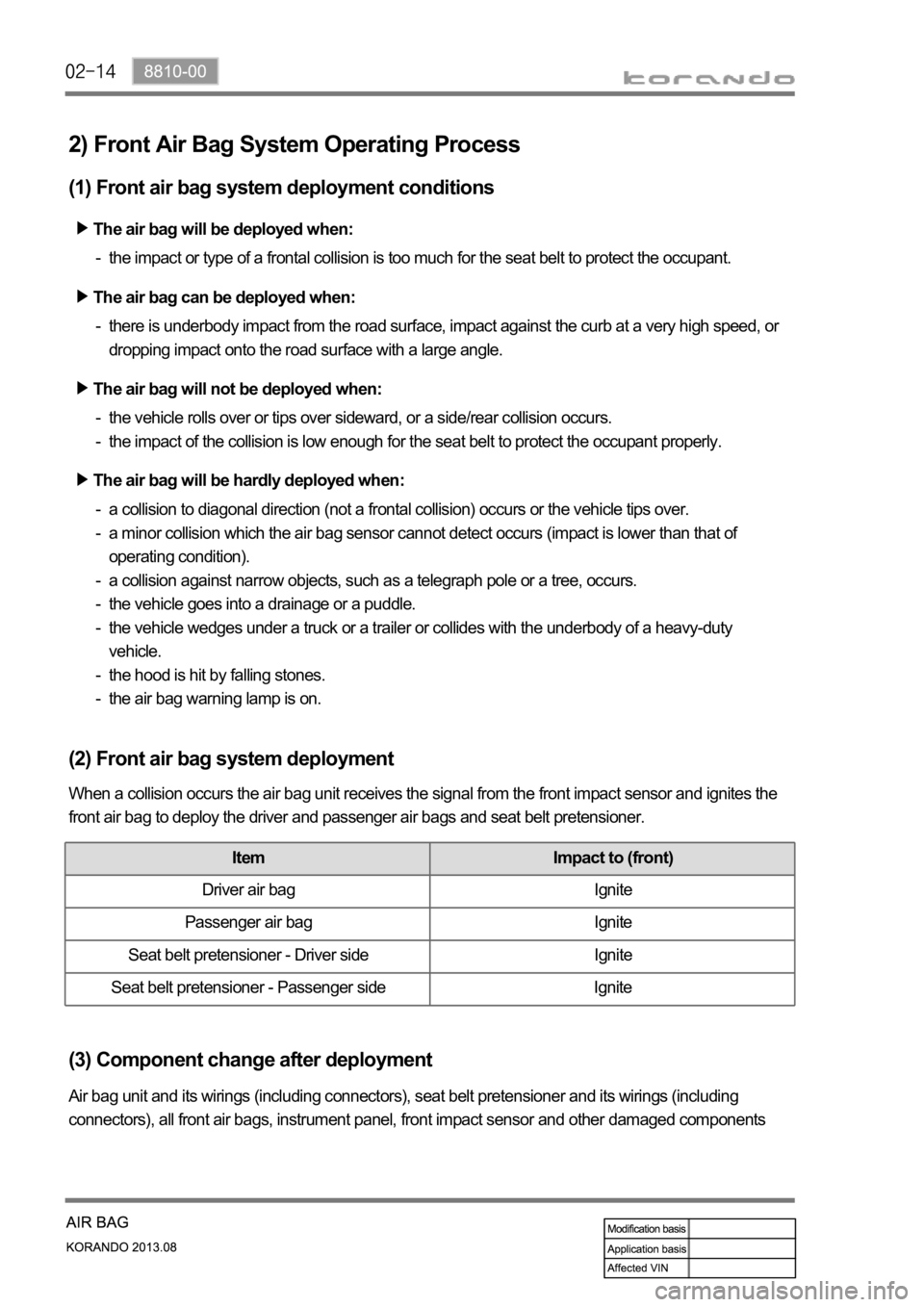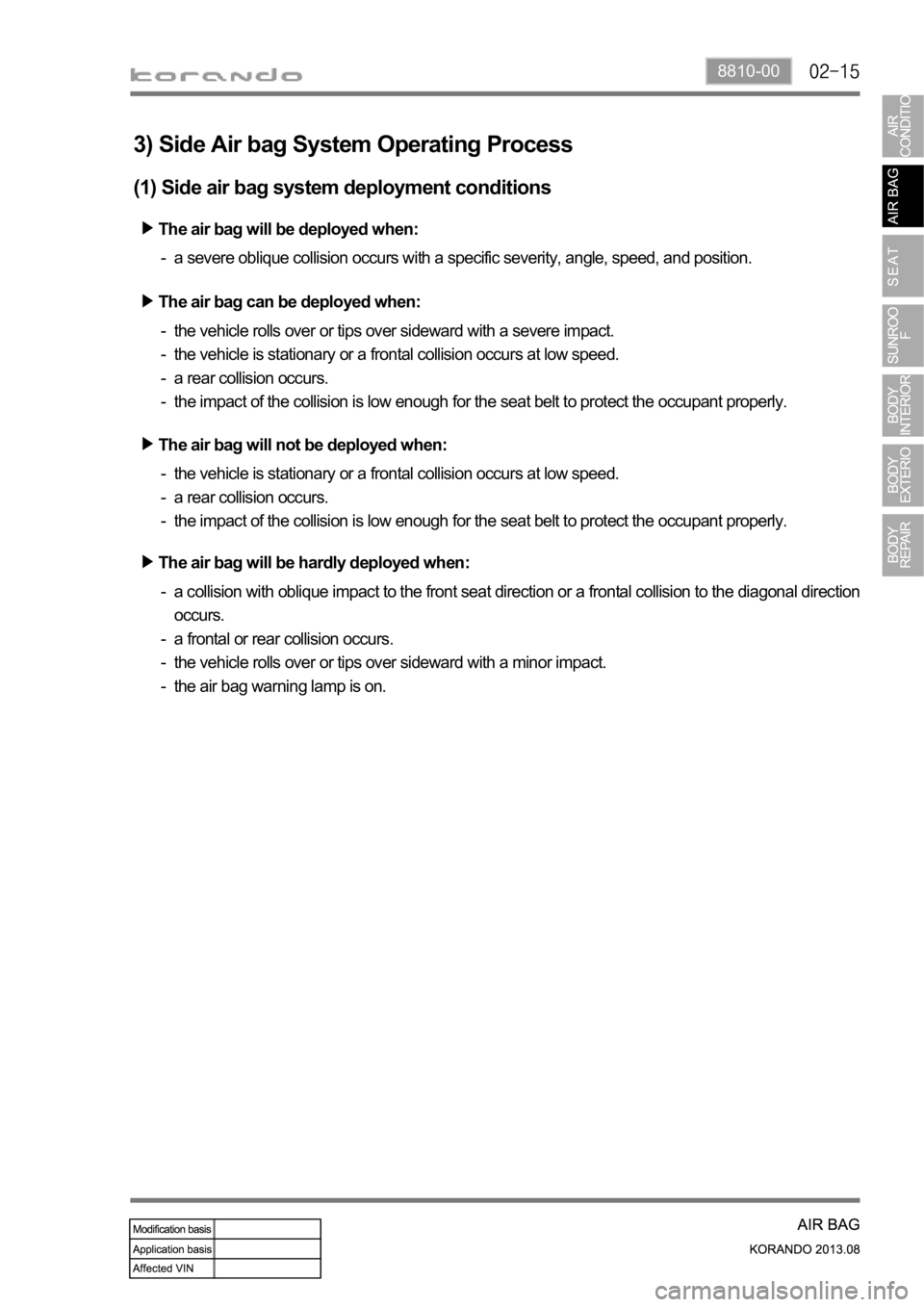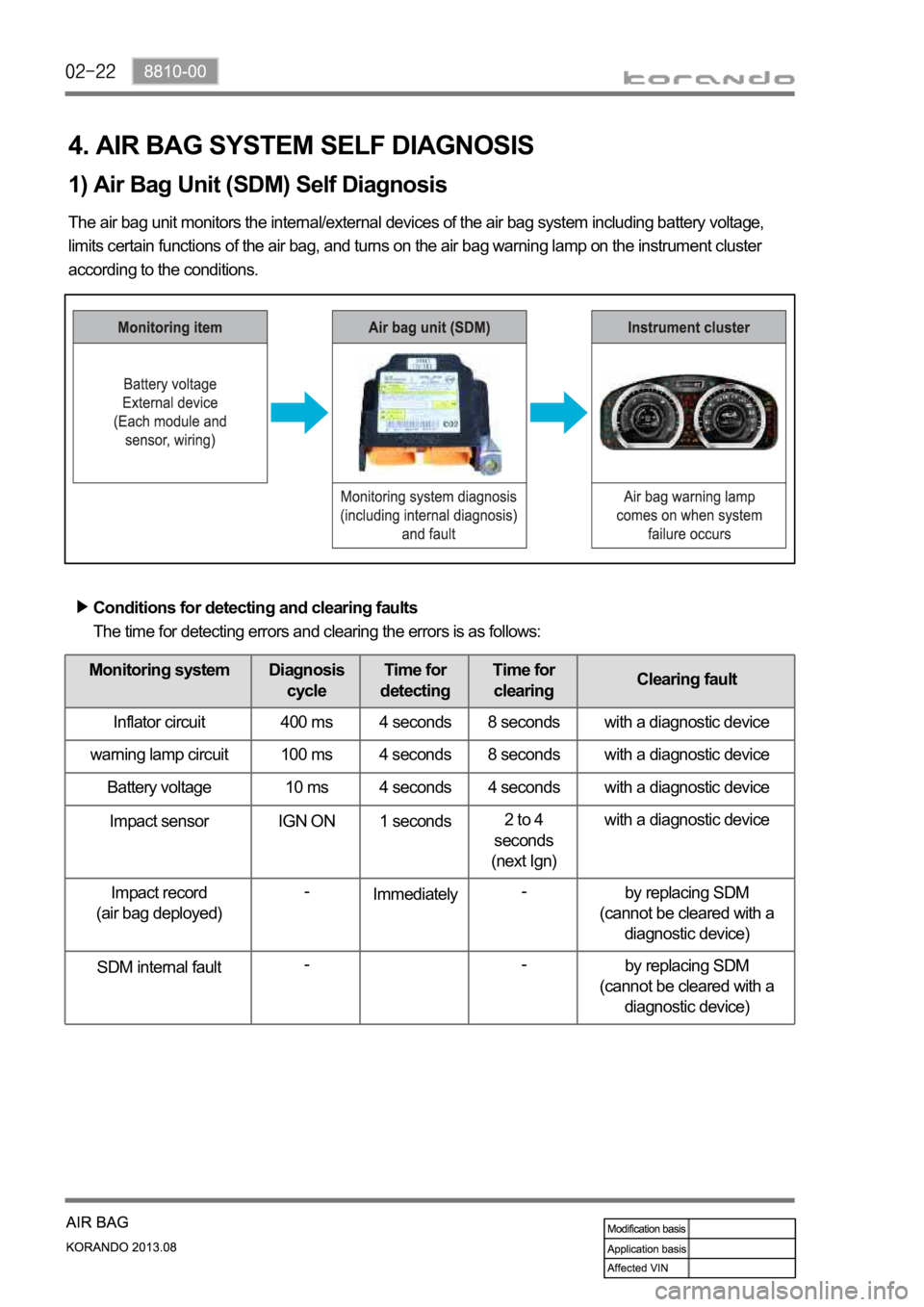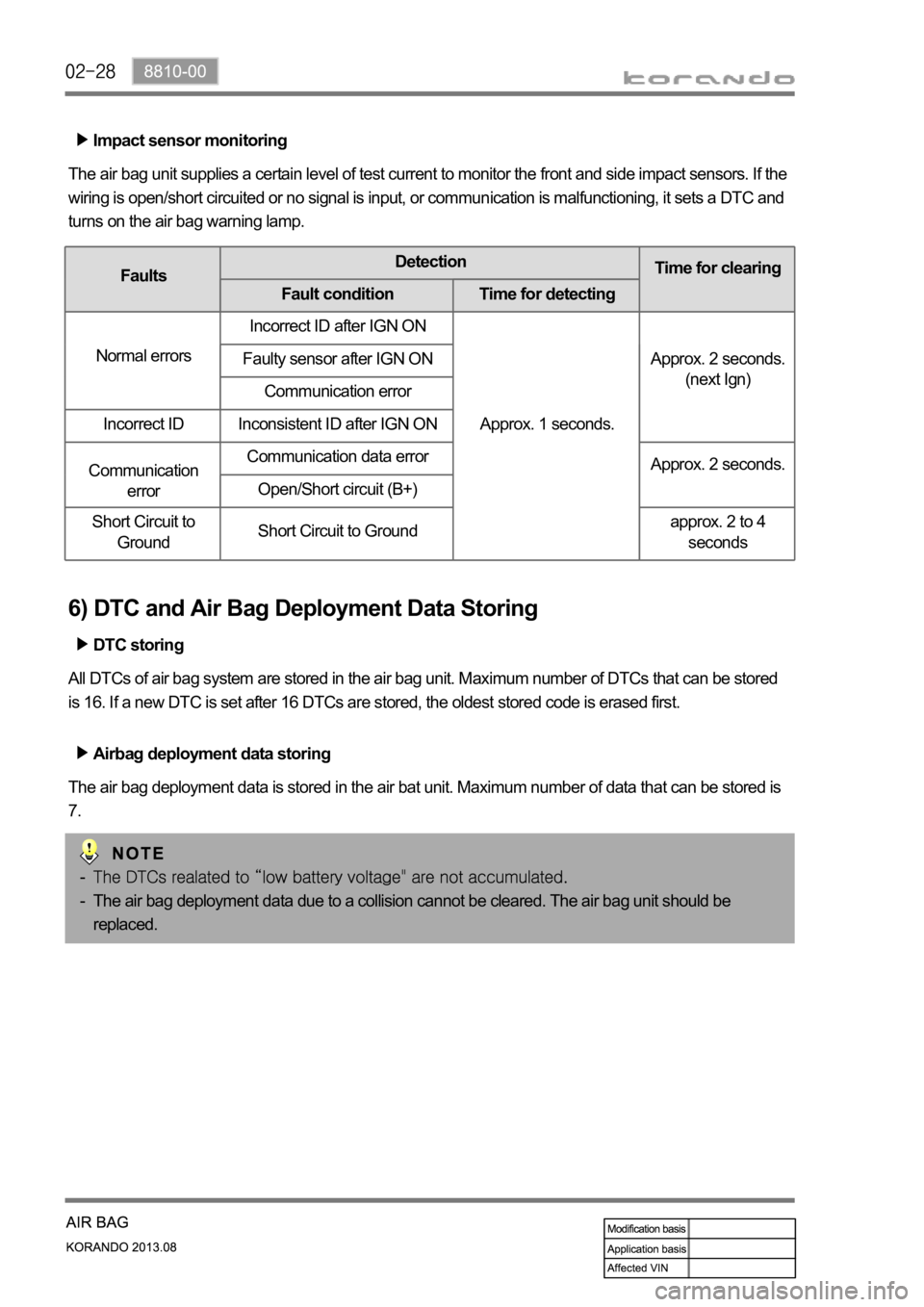Page 1237 of 1336

The air bag will be deployed when:
The air bag can be deployed when:
the impact or type of a frontal collision is too much for the seat belt to protect the occupant. -
a collision to diagonal direction (not a frontal collision) occurs or the vehicle tips over.
a minor collision which the air bag sensor cannot detect occurs (impact is lower than that of
operating condition).
a collision against narrow objects, such as a telegraph pole or a tree, occurs.
the vehicle goes into a drainage or a puddle.
the vehicle wedges under a truck or a trailer or collides with the underbody of a heavy-duty
vehicle.
the hood is hit by falling stones.
the air bag warning lamp is on. -
-
-
-
-
-
-the vehicle rolls over or tips over sideward, or a side/rear collision occurs.
the impact of the collision is low enough for the seat belt to protect the occupant properly. -
-
The air bag will be hardly deployed when:
2) Front Air Bag System Operating Process
(1) Front air bag system deployment conditions
there is underbody impact from the road surface, impact against the curb at a very high speed, or
dropping impact onto the road surface with a large angle. -
The air bag will not be deployed when:
(2) Front air bag system deployment
When a collision occurs the air bag unit receives the signal from the front impact sensor and ignites the
front air bag to deploy the driver and passenger air bags and seat belt pretensioner.
Item Impact to (front)
Driver air bag Ignite
Passenger air bag Ignite
Seat belt pretensioner - Driver side Ignite
Seat belt pretensioner - Passenger side Ignite
(3) Component change after deployment
Air bag unit and its wirings (including connectors), seat belt pretensioner and its wirings (including
connectors), all front air bags, instrument panel, front impact sensor and other damaged components
Page 1238 of 1336

8810-00
The air bag will be deployed when:
The air bag can be deployed when:
a severe oblique collision occurs with a specific severity, angle, speed, and position. -
a collision with oblique impact to the front seat direction or a frontal collision to the diagonal direction
occurs.
a frontal or rear collision occurs.
the vehicle rolls over or tips over sideward with a minor impact.
the air bag warning lamp is on. -
-
-
-the vehicle is stationary or a frontal collision occurs at low speed.
a rear collision occurs.
the impact of the collision is low enough for the seat belt to protect the occupant properly. -
-
-
The air bag will be hardly deployed when:
3) Side Air bag System Operating Process
(1) Side air bag system deployment conditions
the vehicle rolls over or tips over sideward with a severe impact.
the vehicle is stationary or a frontal collision occurs at low speed.
a rear collision occurs.
the impact of the collision is low enough for the seat belt to protect the occupant properly. -
-
-
-
The air bag will not be deployed when:
Page 1245 of 1336

4. AIR BAG SYSTEM SELF DIAGNOSIS
1) Air Bag Unit (SDM) Self Diagnosis
The air bag unit monitors the internal/external devices of the air bag system including battery voltage,
limits certain functions of the air bag, and turns on the air bag warning lamp on the instrument cluster
according to the conditions.
Conditions for detecting and clearing faults
The time for detecting errors and clearing the errors is as follows:
Monitoring system Diagnosis
cycleTime for
detectingTime for
clearingClearing fault
Inflator circuit 400 ms 4 seconds 8 seconds with a diagnostic device
warning lamp circuit 100 ms 4 seconds 8 seconds with a diagnostic device
Battery voltage 10 ms 4 seconds 4 seconds with a diagnostic device
Impact sensor IGN ON 1 seconds2 to 4
seconds
(next Ign)with a diagnostic device
Impact record
(air bag deployed)-
Immediately-
by replacing SDM
(cannot be cleared with a
diagnostic device)
SDM internal fault--
by replacing SDM
(cannot be cleared with a
diagnostic device)
Page 1250 of 1336
8810-00
5) External monitoring
The air bag unit supplies a certain level of test current and monitors the resistance of the inflator circuit
within a specified range to deploy the air bag. It limits certain functions of the air bag, sets a DTC and
turns on the air bag warning lamp according to the conditions.
Inflator circuit resistance monitoring
Page 1251 of 1336

Impact sensor monitoring
The air bag unit supplies a certain level of test current to monitor the front and side impact sensors. If the
wiring is open/short circuited or no signal is input, or communication is malfunctioning, it sets a DTC and
turns on the air bag warning lamp.
FaultsDetection
Time for clearing
Fault condition Time for detecting
Normal errorsIncorrect ID after IGN ON
Approx. 1 seconds.Approx. 2 seconds.
(next Ign) Faulty sensor after IGN ON
Communication error
Incorrect ID Inconsistent ID after IGN ON
Communication
errorCommunication data error
Approx. 2 seconds.
Open/Short circuit (B+)
Short Circuit to
GroundShort Circuit to Groundapprox. 2 to 4
seconds
6) DTC and Air Bag Deployment Data Storing
DTC storing
Airbag deployment data storing
The air bag deployment data due to a collision cannot be cleared. The air bag unit should be
replaced. -
- All DTCs of air bag system are stored in the air bag unit. Maximum number of DTCs that can be stored
is 16. If a new DTC is set after 16 DTCs are stored, the oldest stored code is erased first.
The air bag deployment data is stored in the air bat unit. Maximum number of data that can be stored is
7.
Page 1252 of 1336
8810-00
5. EVENT DATA RECORDER (EDR)
The event data recorder (EDR) stores the driving information data in a crash or near crash event, when
the acceleration sensor in the air bag unit detects a sharp acceleration change which meets the EDR
operating conditions, regardless of the air bag deployment The air bag unit always stores the driving
information data and updates the data with new one periodically. If a collision is detected by front and
side impact sensors, the acceleration sensor in the SDM detects the change in acceleration. The air bag
unit stores the information on internal acceleration sensor, driving status and air bag deployment at this
time.
The EDR stores the driving information also when the acceleration sensor in the air bag unit detects
a sharp acceleration change in the event of a rear-end collision or side collision for a vehicle without
an air bag
Page 1298 of 1336
When you drive this vehicle with the window or sunroof open at a certain position, you may feel
some pressure upon your ears or hear some noises similar to those from a helicopter. This happens
because of an influx in air through the window or sunroof and its resonance effect. If this happens,
adjust by opening the window or sunroof. - The anti-pinch function is deactivated just before the sunroof closes.
The sunroof safety function is just a safety supplementary system which cannot replace driver's care
and caution. Moreover, it may not be able to operate due to electric part or other conditions. To prevent any body parts from being trapped by the sliding sunroof, an Anti-Pinch Function
automatically opens the sunroof when an object is trapped.
4) Sunroof Safety Function
Wind buffeting